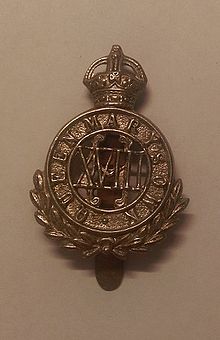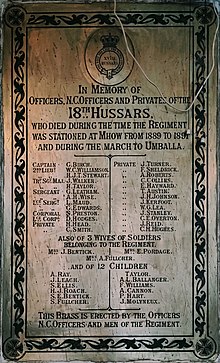| 18th Royal Hussars (Queen Mary's Own) | |
|---|---|
 Badge of the 18th Royal Hussars Badge of the 18th Royal Hussars | |
| Active | 1759–1821 1858–1922 |
| Country | |
| Branch | |
| Type | Cavalry |
| Role | Line Cavalry |
| Size | 1 Regiment |
| Nickname(s) | The Young 15th The Drogheda Light Horse |
| Motto(s) | Pro rege, pro lege, pro patria conamur (For King, for Law, for Country we strive) |
| Commanders | |
| Notable commanders | Field Marshal Charles Moore, 1st Marquess of Drogheda General Sir Edward Hodge |
The 18th Royal Hussars (Queen Mary's Own) was a cavalry regiment of the British Army, first formed in 1759. It saw service for two centuries, including the First World War before being amalgamated with the 13th Hussars to form the 13th/18th Royal Hussars in 1922.
History
Early history

The regiment was first raised by Charles, Marquess of Drogheda as the 19th Regiment of (Light) Dragoons in 1759; it was also known as Drogheda's Light Horse. It was renumbered the 18th Regiment of (Light) Dragoons in 1763, and briefly the 4th Regiment of Light Dragoons in 1766 before reverting to the 18th in 1769. Arthur Wellesley was briefly a junior officer in the regiment between October 1792 and April 1793. The regiment undertook a one-year tour in Saint-Domingue between February 1796 and February 1797. It was in action at the Battle of Bergen in September 1799 during the Anglo-Russian invasion of Holland.
In 1805 it took the title of the 18th (King's Irish) Regiment of (Light) Dragoons, named for George III, and redesignated as hussars in 1807, becoming the 18th (King's Irish) Regiment of (Light) Dragoons (Hussars). The regiment landed at Lisbon in July 1808 for service in the Peninsular War. It fought at the Battle of Benavente in December 1808 and at the Battle of Cacabelos in January 1809 before taking part in the Battle of Corunna and the subsequent return to England later that month.
The regiment was ordered to support Sir Arthur Wellesley's Army on the Iberian Peninsula and landed at Lisbon in February 1813. It saw action at the Battle of Morales in June 1813, and the Battle of Vitoria in June 1813. It went on to fight at the Battle of Sorauren in July 1813 and, having advanced into France, at the Battle of the Nive in December 1813, at the Battle of Orthez in February 1814 and at the Battle of Toulouse in April 1814. It returned home in July 1814.
The regiment took part in the Hundred Days landing at Ostend in April 1815. It charged the centre of the French position at the Battle of Waterloo in June 1815. It then remained in France as part of the Army of Occupation brigaded with the 12th (Prince of Wales's) Regiment of (Light) Dragoons under the overall command of Major-General Sir Hussey Vivian. It was disbanded in Ireland in 1821.
Re-formed

The regiment was reformed in Leeds in 1858, as the 18th Regiment of (Light) Dragoons from a nucleus taken from the 15th Hussars, and was renamed the 18th Hussars in 1861.

The regiment was deployed to South Africa in 1899 for service in the Second Boer War. At the outbreak of hostilities on 11 October 1899 it was one of only two regular cavalry regiments in South Africa. In the Battle of Talana Hill, on 20 October, part of the regiment was cut off by Boer forces and about 249 officers and men, including Lieutenant Colonel Benhardt Moller, were taken prisoner. Following a critical report, Moller was deprived of his command and placed on half-pay.
The reorganised regiment subsequently saw action during the Siege of Ladysmith. They stayed in South Africa throughout the war, which ended June 1902 with the Peace of Vereeniging. Four months later, 590 officers and men left Cape Town on the SS Englishman in late September 1902, and arrived at Southampton in late October, when they were posted to Aldershot Garrison.
In 1903 it was named the 18th (Princess of Wales's Own) Hussars, for Princess Mary, being retitled the 18th (Victoria Mary, Princess of Wales's Own) Hussars in 1905 and the 18th (Queen Mary's Own) Hussars in 1910 to mark her coronation as Queen Consort.
The regiment, having been based at Tidworth Camp at the start of the First World War, landed at Boulogne-sur-Mer as part of the 2nd Cavalry Brigade in the 1st Cavalry Division in August 1914 for service on the Western Front. The regiment was retitled as the 18th (Queen Mary's Own) Royal Hussars in 1919 and then as the 18th Royal Hussars (Queen Mary's Own) in 1921. It amalgamated with the 13th Hussars to form the 13th/18th Royal Hussars in 1922. On amalgamation, the 18th formed A Squadron of the 13/18, leading to A Sqn being known as "The 18th Hussar Squadron".
Regimental museum
The regimental collection is held by the Discovery Museum in Newcastle upon Tyne.
Colonels
Colonels of the regiment were:
| Name | Appointment |
|---|---|
| F.M. Charles, Marquess of Drogheda | 3 August 1762 |
| Lt-Gen. Edward Byam | 16 November 1858 |
| Gen. Sir Charles Routledge O'Donnell | 10 September 1864 |
| Gen. Sir Edward Cooper Hodge, GCB | 19 November 1870 |
| Gen. Sir Thomas Westropp McMahon, Bt., CB | 6 January 1874 |
| Lt-Gen. Sir William Drysdale, KCB | 16 March 1885 |
| Lt-Gen. Richard Knox | 11 June 1891 |
| Gen. Sir Alexander George Montgomery Moore, KCB | 4 January 1892 |
| Maj-Gen. Thomas Phillips | 9 July 1904 |
| Maj-Gen. Sir John Palmer Brabazon, KCB, CVO | 10 November 1913 |
Commanding officers
The commanding officers of the regiment included:
| Name | Appointment |
|---|---|
| Richard Georges | 17 June 1761 |
| William Hardcourt | 17 April 1765 |
| Edward Walpole | 25 June 1768 |
| Charles Wilson Lyon | 13 April 1771 |
| Charles W. Vane Stewart | 12 April 1799 |
| Oliver Thomas Jones | 29 January 1801 |
| Henry Murray | 2 January 1812 |
| Richard Knox | 23 February 1858 |
| Percival Scrope Marling | 19 February 1902 |
Battle honours
The regiment's battle honours were as follows:
- Peninsula, Waterloo, Defence of Ladysmith, South Africa 1899-1902
- The Great War: Mons, Le Cateau, Retreat from Mons, Marne 1914, Aisne 1914, La Bassée 1914, Messines 1914, Armentières 1914, Ypres 1914 '15, Gravenstafel, St. Julien, Frezenberg, Bellewaarde, Somme 1916 '18, Flers-Courcelette, Arras 1917, Scarpe 1917, Cambrai 1917 '18, St. Quentin, Rosières, Amiens, Albert 1918, Hindenburg Line, Pursuit to Mons, France and Flanders 1914-18
Uniforms
When reraised in 1858 the regiment wore the standard dark blue uniform and elaborate yellow braiding of regular British hussars of the period. Busby bags and plumes were in the unique colour of Lincoln green. Battle honours won by the previous 18th Hussars, disbanded in 1821, were restored and displayed on the gold braided pouch belts and sabretaches (ornamental pouches) of the officers. In 1878 the green facings were replaced by blue bags and white plumes which had distinguished the original 18th Hussars. The horse furniture of officers included red and white throat plumes and leopardskins under the saddle. Khaki service dress was adopted in 1902 but the colourful and expensive dress described above was retained for full dress until the outbreak of war in 1914.
See also
Notes
- Lord Drogheda entered the British Army, as cornet in the 12th Dragoons on 1 May 1744; was gazetted as Colonel of the 18th Hussars 3 August 1762; and died on 22 of December 1821; having been colonel of the Regiment for sixty-two years.
- Lieutenant-General Byam served the campaigns of 1812, '13, '14, and '15, including the battles of Salamanca, Vitoria, Orthez, and Waterloo, besides minor affairs. Severely wounded by a grape-shot while carrying the regimental colour of the 38th at Salamanca, and slightly wounded at Waterloo. He has received the War Medal with three Clasps. Major-General Byam's first commission was an ensigncy in the 38th, with which regiment he served two campaigns: all his other commissions and the rest of his service were in the 15th Hussars.
- Sir Charles O'Donnell was present with the Russian troops in the campaign of 1828 on the Danube against the Turks; and in 1849 with the German troops in Schleswig-Holstein and Jutland, especially at Duppel and the battle of Fredericia.
References
- ^ "18th Royal Hussars (Queen Mary's Own)". Regiments.org. Archived from the original on 8 September 2006. Retrieved 5 September 2016.
- Malet, p. 13
- Malet, p. 14
- ^ Malet, p. 16
- Malet, p. 18
- Malet, p. 20
- Malet, p. 22
- Malet, p. 24
- Malet, p. 26
- Malet, p. 27
- Malet, p. 29
- Malet, p. 34
- Malet, p. 35
- Malet, p. 36
- Malet, p. 47
- Malet, p. 54
- The Marquess of Anglesey, page 202, "A History of British Cavalry, Volume 4"
- "18th Hussars". Anglo-Boer War. Retrieved 5 September 2016.
- "The Army in South Africa - Troops returning Home". The Times. No. 36888. London. 2 October 1902. p. 4.
- "The Hussars". The Long, Long Trail. Retrieved 5 September 2016.
- "Charge! The story of England's Northern Cavalry". Light Dragoons. Retrieved 2 June 2018.
- Malet, p. 62
- Malet, pp. 62–63
- ^ Malet, p. 63
- Carman, W. Y. Richard Simkin's Uniforms of the British Army. The Cavalry Regiments. pp. 184–185. ISBN 0-906671-13-2.
Sources
 This article incorporates text from this source, which is in the public domain: Malet, Harold Esdaile (1869). Historical records of the Eighteenth Hussars. W. Clowes.
This article incorporates text from this source, which is in the public domain: Malet, Harold Esdaile (1869). Historical records of the Eighteenth Hussars. W. Clowes.
| Light Dragoons | |||||
|---|---|---|---|---|---|
| Predecessors |
| ||||
| Victoria Cross | |||||
| See also | |||||
Categories: